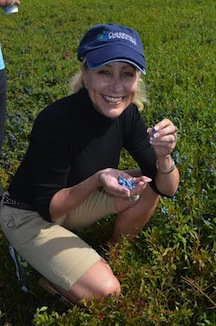By Susan Irby
It’s hard to imagine that more than 10,000 years ago, parts of the United States were covered by glaciers. Once a barren land of ice, the ice receded giving way to the birth of new land, streams, and vegetation including the wild blueberries of Maine. Wild blueberries grow naturally in Maine, Eastern Canada and Quebec with over 60,000 acres in Maine making it the world’s largest producer.
Most people get confused when it comes to blueberries. They imagine a flourishing tall “high bush” filled with lush, plump berries that are picked in the summertime. But the original blueberries were wild. Rising up through the glacial soil from roots called rhizomes that today can span entire fields the size of football fields and beyond from one plant alone. These are the low bushes. The wild, not “tame” or cultivated, blueberries that pack more than 2 times the antioxidants as their tame (as designated by the USDA) counterparts. Even the US High Blueberry Council states that “all blueberries originated from the wilds”.
Why is this so important? Wild blueberries, while not all are organic, claim the lowest in pesticides due to the cooler temperatures they thrive in and the naturally occurring two-year cropping cycle. Most “tame” cultivated blueberries are harvested every year in warmer climates thereby promoting more insects. Eww! Another reason for the success of the wild blueberry in recent decades is due to pollination. While local bumblebees and other native pollinators do a great job nurturing the wild blueberries, about 75,000 honey bee hives are brought in each year to the Maine region which naturally increases the seed number resulting in more wild blueberries! On average, the wild blueberry crop produces over 86 million pounds. Harvesting begins when the wild blueberries are ripe and ready to pick. A mechanical tractor equipped with rakes and trays is commonly used and hand-raking is also still popular today in which a metal rake is held with two hands and used to scoop up the berries which are then transferred into a bin ready for processing at one of six processing plants. Because of their delicate nature, wild blueberries are rinsed, blown, rinsed, blown, and rinsed again to remove any field residue and prepare them for freezing. Yep, some wild blueberries are packaged fresh and sold at local markets while the majority are frozen through an IQF process which ensures that each blueberry is individually quick frozen at the time of ultimate ripeness thereby locking in the maximum flavor and antioxidant benefit. These quick frozen blueberries are then shipped at premium ripeness to stores around the country and the world and used in some of your favorite products such as muffin and pancake mixes, jams, jellies, or frozen whole in packages for you to incorporate into your own recipes.
You’ve probably heard that blueberries help fight cancer. But, did you know that wild blueberries have the 3rd highest concentration of the phytochemical anthocyanin next to pomegranates and acai? Because of their density and higher skin-to-pulp ratio, wild blueberries are even more powerful in disease fighting protocols than their tame, cultivated cousins including Alzheimer’s, heart disease, reducing risk for diabetes and they are high in lutein which promotes good eyesight.
You can find frozen wild blueberries in the freezer section at your local grocery store. If you can’t find them, ask your grocer to bring them in or reach out to the Wild Blueberry Association at www.wildblueberries.com. They also welcome your creative wild blueberry recipes there, so submit and your recipe may be featured.














